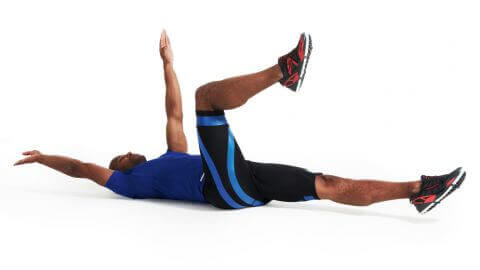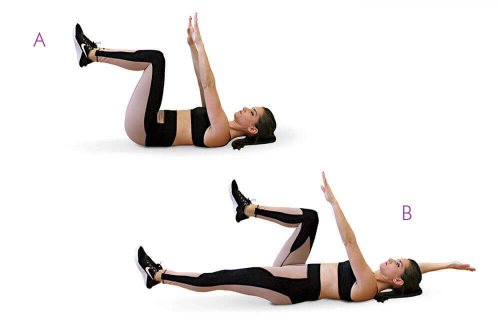The Dead Bug: Exercises to Strengthen Your Abs

With a somewhat strange name, the dead bug is all the rage in the world of fitness and Pilates. It’s a very simple exercise that allows you to strengthen your abs and work the core. Find out more about it in the following article.
You might like: The Crunch: A Basic Exercise to Strengthen your Abs
What is the dead bug?
For the dead bug, the idea is to lay on your back with your legs and arms ‘in the air’. This position is similar to the pose an insect does when it meets its demise.
If you want to work your core, maybe you’re thinking more about planks? However, you can also choose another way to define your abs without making your lower back work too hard.
You might like: Pulley Exercises that Train the Abs
This exercise is widely used in Pilates routines, but it has also taken center stage in abdominal sessions in the gym, due to its effectiveness in working the core. Although it seems simple, it actually isn’t, as it requires stability, abdominal strength and rhythmic movements.
The idea of the dead bug is to move slowly. If it still seems simple (for example, if you’re in really good shape), you can complicate it more by placing a weighted disc on your abdomen.
How to do the dead bug
The dead bug is a typical exercise in Pilates routines. As with most exercises, the movements range from the simplest to more complicated. To start out, you can try the most basic variation:
- Lie on your back on a mat. Stretch out your arms and legs for a few seconds.
- Bend your knees and rest the soles of your feet on the floor.
- Stretch out your arms so they are in line with your shoulders (with your hands pointing towards the ceiling) and lift your legs off the floor. The idea is to get your calves perpendicular to the floor. This is the dead bug position!
- Now the complicated part begins, or at least the part that requires concentration: stretch your right arm towards the floor and bring it behind your head, until almost touching the ground.
- At the same time, lower your left leg and bring it down as far as you can. You can even touch the floor with your toes but don’t put any weight on them.
- Repeat these last two steps with your left arm and right leg. The goal is to synchronize the movements and always move the opposite arms and legs.
More variations
There are different variations of this exercise that you can do once you have practiced it several times. Consider the following variations when the original is no longer a challenge for your abs.
As a first option, stretch out your legs instead of leaving them bent. The goal is that you do not touch the ground at any time. The rest of the exercise is the same as the basic one. You’ll see how much you’re working your lower abs. Everything will become more difficult!
Another good way to make the dead bug more complex is to add weight. How? Very easy: with a disc resting on your abdomen, ankles or with dumbbells in your hands. Some people also take a medicine ball with their moving hand and pass it off to the other hand when alternating.
Furthermore, you can also alternate the movement of your legs but keep your arms moving together. To do this, bend your knees towards your chest and hold a disc with both hands. Bring your arms back while stretching your right leg. Bring your arms and leg back to the start position and then do the same but with the left leg.
If that still seems too simple, you can try the following: lay on your back with your arms and legs stretched out. Raise your right arm and left leg. Then, try to touch your toes with your fingers. The limbs that are still on the floor have to be well stretched out, waiting for their turn to lift.
Go slow and listen to your body
The dead bug exercise is very good for working the core and has to be done in a leisurely and balanced way. Additionally, this is the only way you can achieve your goal of defining your abdominals and using the correct technique!
Once you have done this exercise several times, its time to add difficulty. However, never try to do the more difficult versions without practicing the simpler ones first. Finally, remember that the body needs to take one step at a time. This is the best way to get results and improve yourself every day or with each session!
With a somewhat strange name, the dead bug is all the rage in the world of fitness and Pilates. It’s a very simple exercise that allows you to strengthen your abs and work the core. Find out more about it in the following article.
You might like: The Crunch: A Basic Exercise to Strengthen your Abs
What is the dead bug?
For the dead bug, the idea is to lay on your back with your legs and arms ‘in the air’. This position is similar to the pose an insect does when it meets its demise.
If you want to work your core, maybe you’re thinking more about planks? However, you can also choose another way to define your abs without making your lower back work too hard.
You might like: Pulley Exercises that Train the Abs
This exercise is widely used in Pilates routines, but it has also taken center stage in abdominal sessions in the gym, due to its effectiveness in working the core. Although it seems simple, it actually isn’t, as it requires stability, abdominal strength and rhythmic movements.
The idea of the dead bug is to move slowly. If it still seems simple (for example, if you’re in really good shape), you can complicate it more by placing a weighted disc on your abdomen.
How to do the dead bug
The dead bug is a typical exercise in Pilates routines. As with most exercises, the movements range from the simplest to more complicated. To start out, you can try the most basic variation:
- Lie on your back on a mat. Stretch out your arms and legs for a few seconds.
- Bend your knees and rest the soles of your feet on the floor.
- Stretch out your arms so they are in line with your shoulders (with your hands pointing towards the ceiling) and lift your legs off the floor. The idea is to get your calves perpendicular to the floor. This is the dead bug position!
- Now the complicated part begins, or at least the part that requires concentration: stretch your right arm towards the floor and bring it behind your head, until almost touching the ground.
- At the same time, lower your left leg and bring it down as far as you can. You can even touch the floor with your toes but don’t put any weight on them.
- Repeat these last two steps with your left arm and right leg. The goal is to synchronize the movements and always move the opposite arms and legs.
More variations
There are different variations of this exercise that you can do once you have practiced it several times. Consider the following variations when the original is no longer a challenge for your abs.
As a first option, stretch out your legs instead of leaving them bent. The goal is that you do not touch the ground at any time. The rest of the exercise is the same as the basic one. You’ll see how much you’re working your lower abs. Everything will become more difficult!
Another good way to make the dead bug more complex is to add weight. How? Very easy: with a disc resting on your abdomen, ankles or with dumbbells in your hands. Some people also take a medicine ball with their moving hand and pass it off to the other hand when alternating.
Furthermore, you can also alternate the movement of your legs but keep your arms moving together. To do this, bend your knees towards your chest and hold a disc with both hands. Bring your arms back while stretching your right leg. Bring your arms and leg back to the start position and then do the same but with the left leg.
If that still seems too simple, you can try the following: lay on your back with your arms and legs stretched out. Raise your right arm and left leg. Then, try to touch your toes with your fingers. The limbs that are still on the floor have to be well stretched out, waiting for their turn to lift.
Go slow and listen to your body
The dead bug exercise is very good for working the core and has to be done in a leisurely and balanced way. Additionally, this is the only way you can achieve your goal of defining your abdominals and using the correct technique!
Once you have done this exercise several times, its time to add difficulty. However, never try to do the more difficult versions without practicing the simpler ones first. Finally, remember that the body needs to take one step at a time. This is the best way to get results and improve yourself every day or with each session!
All cited sources were thoroughly reviewed by our team to ensure their quality, reliability, currency, and validity. The bibliography of this article was considered reliable and of academic or scientific accuracy.
- Andrew Raposo. The Completa Fighter Abs Manual: Get abs like a fighter. Recuerado de: https://fighterabs.com/wp-content/uploads/2014/05/Fighter-Abs-Manual.pdf
This text is provided for informational purposes only and does not replace consultation with a professional. If in doubt, consult your specialist.










